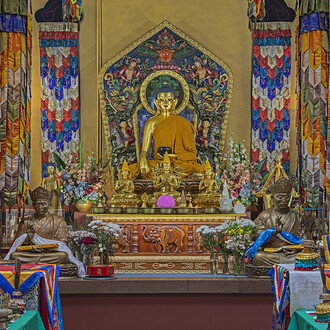In the year that sees the 550th anniversary of the birth of Michelangelo di Lodovico di Leonardo di Buonarroti Simoni (1475–1564), known to the whole world by just his first name, the Hermitage is telling about the circle and followers of a superlative artist of the Modern Era.
At the centre of the exhibition is the marble statue known by the title The crouching boy, a rare work by Michelangelo located outside of Italy and the only one in Russia. It came into the imperial collection as far back as 1784, from England as part of the collection of Lyde Browne. The statue is unfinished, as indeed are the majority of the master’s works. For all that, the image that he created is extremely expressive. The youth depicted squatting down is full of strength and physically robust, but his spirit is broken. Only a great sculptor could create such a profound piece.
Arranged around The crouching boy are 13 sculptures and 11 paintings made by friends, rivals, pupils and imitators of Michelangelo. These works are graphic proof of the depth and extent of the influence that the master’s ideas had on artists in the 1500s and the centuries that followed.
Some of the sculptures featured in the exhibition were previously considered to be works by Michelangelo himself. They include the statues Pietà, Moses, Day, Evening and Shackled slave, each produced by an unknown sculptor after an original by Buonarroti, and also Nicodemus with the body of Christ by Stefano Maderno, Sleeping Hercules and Head of a faun by Baccio Bandinelli, who considered himself a rival and competitor to Michelangelo.
The display is augmented by two marble busts that are portraits of Michelangelo. One of them can be dated to the mid-19th century and is based on the sculptor’s death mask. The other bust stands out for its non-traditional approach. It may have been made during the artist’s lifetime and can be attributed to Giovanni Antonio Dosio, a Tuscan sculptor and architect who was part of Michelangelo’s circle in Rome.
The painting section of the exhibition gives visitors an idea of the manner employed by early 16th-century artists who came under the influence of Michelangelo. They will see pictures by Marcello Venusti, Perino del Vaga and Giuliano Bugiardini, as well as works from the school of Giorgio Vasari and the studio of Lorenzo di Credi. The display includes a few paintings by unknown artists of the middle and second half of the 16th century with compositions that derive from various inventions of Michelangelo.
The exhibition has been organized by the State Hermitage with the participation of the Pushkin State Museum of Fine Arts (Moscow), the State Museum of the History of Religion and the Museum of Christian Culture (both in Saint Petersburg).
The exhibition curators are Sergei Olegovich Androsov, chief researcher in the State Hermitage’s Department of Western European Fine Art, and Zoya Vladimirovna Kuptsova, senior researcher in the same department.
An illustrated publication has been prepared to accompany the exhibition, with texts by researchers and keepers of the Renaissance collection in the Hermitage and art historians from Russia and Italy.
The exhibition The divine Michelangelo and his contemporaries can be visited by all holders of entrance tickets to the Main Museum Complex until 24 August 2025.
















